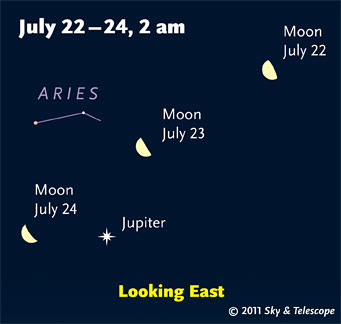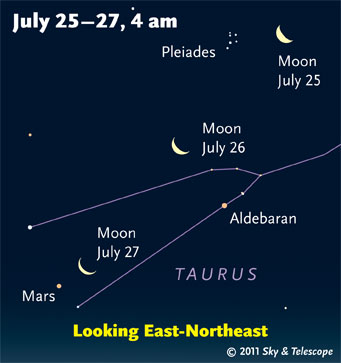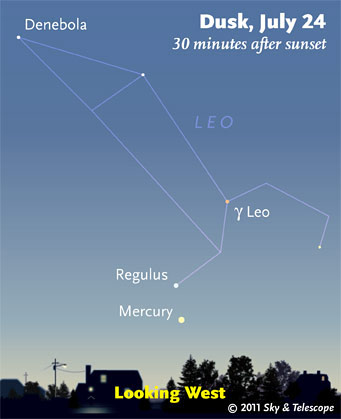
Night owls can watch the waning Moon pass bright Jupiter.
Sky & Telescope diagram
Friday, July 22
Saturday, July 23
Sunday, July 24
Look far to the right of Arcturus, at roughly the same height, for the Big Dipper.
Monday, July 25
Tuesday, July 26

The Moon before dawn now lights the way to Mars and Aldebaran. (These scenes are drawn for the middle of North America. European observers: move each Moon symbol a quarter of the way toward the one for the previous date. For clarity, the Moon is shown three times its actual size.)
Sky & Telescope diagram
Wednesday, July 27
Thursday, July 28
Friday, July 29
Saturday, July 30
Want to become a better amateur astronomer? Learn your way around the constellations. They're the key to locating everything fainter and deeper to hunt with binoculars or a telescope.
For an easy-to-use constellation guide covering the whole evening sky, use the big monthly map in the center of each issue of Sky & Telescope, the essential magazine of astronomy. Or download our free Getting Started in Astronomy booklet (which only has bimonthly maps).

The Pocket Sky Atlas plots 30,796 stars to magnitude 7.6 — which may sound like a lot, but that's less than one star in an entire telescopic field of view, on average. By comparison, Sky Atlas 2000.0 plots 81,312 stars to magnitude 8.5, typically one or two stars per telescopic field. Both atlases include many hundreds of deep-sky targets — galaxies, star clusters, and nebulae — to hunt among the stars.
Sky & Telescope
Once you get a telescope, to put it to good use you must have a detailed, large-scale sky atlas (set of charts). The standards are the Pocket Sky Atlas, which shows stars to magnitude 7.6; the larger Sky Atlas 2000.0 (stars to magnitude 8.5); and the even larger and deeper Uranometria 2000.0 (stars to magnitude 9.75). And read how to use sky charts effectively.
You'll also want a good deep-sky guidebook, such as Sky Atlas 2000.0 Companion by Strong and Sinnott, or the more detailed and descriptive Night Sky Observer's Guide by Kepple and Sanner, or the classic if dated Burnham's Celestial Handbook.
Can a computerized telescope take their place? I don't think so — not for beginners, anyway, and especially not on mounts that are less than top-quality mechanically. As Terence Dickinson and Alan Dyer say in their Backyard Astronomer's Guide, "A full appreciation of the universe cannot come without developing the skills to find things in the sky and understanding how the sky works. This knowledge comes only by spending time under the stars with star maps in hand."
This Week's Planet Roundup

This week, use binoculars to watch Regulus pass fading Mercury after sunset. Their visibility in the bright twilight a half hour after sundown is exaggerated here.
Alan MacRobert
Mercury fades from magnitude +0.4 to +1.0 this week as it sinks even lower toward the sunset horizon. Use binoculars to look for it very low in the west-northwest in bright twilight — and to spot twinkly Regulus, slightly fainter, nearby. Mercury and Regulus pass 3° from each other on July 26th.
Venus is hidden in the sunrise.
Mars (magnitude +1.4, near the horns of Taurus) can be found in the east-northeast as dawn begins to brighten. Look for it very far to the lower left of brilliant Jupiter. Don't confuse Mars with Aldebaran to its upper right. Upper left of Mars is brighter Capella.
In a telescope Mars is just a tiny blob only 4.4 arcseconds in diameter. It's on its way to a poor opposition (13.9 arcseconds wide) next March.
Jupiter (magnitude –2.4, in southern Aries) rises in the east around midnight daylight saving time. Once it's well up, look below it for the head of Cetus, rather dim. By dawn Jupiter shines high in the southeast.
Saturn (magnitude +0.9, in Virgo) is sinking ever lower in the west-southwest at dusk. Shining 13° left of it is similar, but bluer, Spica. About 1½° to 2° to Saturn's right is fainter Porrima (Gamma Virginis).
Uranus (magnitude 5.8, in western Pisces) and Neptune (magnitude 7.8, in western Aquarius) are well up in the early-morning hours. Here's our printable finder chart for both.
Pluto (magnitude 14.0, in northern Sagittarius) is highest in the south around 11 p.m. A big finder chart for it is in the July Sky & Telescope, page 64.
All descriptions that relate to your horizon — including the words up, down, right, and left — are written for the world's mid-northern latitudes. Descriptions that also depend on longitude (mainly Moon positions) are for North America. Eastern Daylight Time (EDT) equals Universal Time (also known as UT, UTC, or GMT) minus 4 hours.
To be sure to get the current Sky at a Glance, bookmark this URL:
http://SkyandTelescope.com/observing/ataglance?1=1
If pictures fail to load, refresh the page. If they still fail to load, change the 1 at the end of the URL to any other character and try again.
 0
0
Comments
You must be logged in to post a comment.